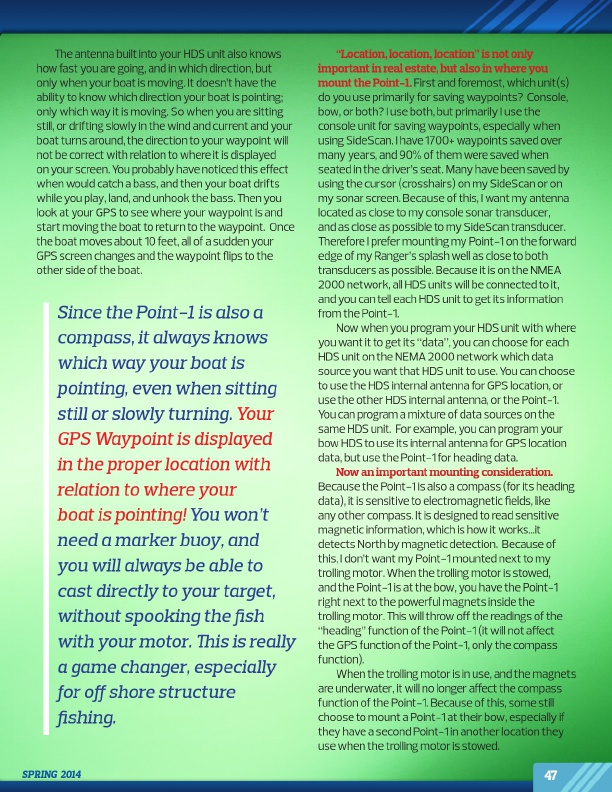
The antenna built into your HDS unit also knows how fast you are going, and in which direction, but only when your boat is moving. It doesn’t have the ability to know which direction your boat is pointing; only which way it is moving. So when you are sitting still, or drifting slowly in the wind and current and your boat turns around, the direction to your waypoint will not be correct with relation to where it is displayed on your screen. You probably have noticed this effect when would catch a bass, and then your boat drifts while you play, land, and unhook the bass. Then you look at your GPS to see where your waypoint is and start moving the boat to return to the waypoint. Once the boat moves about 10 feet, all of a sudden your GPS screen changes and the waypoint flips to the other side of the boat.
Since the Point-1 is also a compass, it always knows which way your boat is pointing, even when sitting still or slowly turning. Your GPS Waypoint is displayed in the proper location with relation to where your boat is pointing! You won’t need a marker buoy, and you will always be able to cast directly to your target, without spooking the fish with your motor. This is really a game changer, especially for off shore structure fishing.
SPRING 2014
“Location, location, location” is not only important in real estate, but also in where you mount the Point-1. First and foremost, which unit(s) do you use primarily for saving waypoints? Console, bow, or both? I use both, but primarily I use the console unit for saving waypoints, especially when using SideScan. I have 1700+ waypoints saved over many years, and 90% of them were saved when seated in the driver’s seat. Many have been saved by using the cursor (crosshairs) on my SideScan or on my sonar screen. Because of this, I want my antenna located as close to my console sonar transducer, and as close as possible to my SideScan transducer. Therefore I prefer mounting my Point-1 on the forward edge of my Ranger’s splash well as close to both transducers as possible. Because it is on the NMEA 2000 network, all HDS units will be connected to it, and you can tell each HDS unit to get its information from the Point-1.
Now when you program your HDS unit with where you want it to get its “data”, you can choose for each HDS unit on the NEMA 2000 network which data source you want that HDS unit to use. You can choose to use the HDS internal antenna for GPS location, or use the other HDS internal antenna, or the Point-1. You can program a mixture of data sources on the same HDS unit. For example, you can program your bow HDS to use its internal antenna for GPS location data, but use the Point-1 for heading data.
Now an important mounting consideration. Because the Point-1 is also a compass (for its heading data), it is sensitive to electromagnetic fields, like any other compass. It is designed to read sensitive magnetic information, which is how it works...it detects North by magnetic detection. Because of this, I don’t want my Point-1 mounted next to my trolling motor. When the trolling motor is stowed, and the Point-1 is at the bow, you have the Point-1 right next to the powerful magnets inside the trolling motor. This will throw off the readings of the “heading” function of the Point-1 (it will not affect the GPS function of the Point-1, only the compass function).
When the trolling motor is in use, and the magnets are underwater, it will no longer affect the compass function of the Point-1. Because of this, some still choose to mount a Point-1 at their bow, especially if they have a second Point-1 in another location they use when the trolling motor is stowed.
47